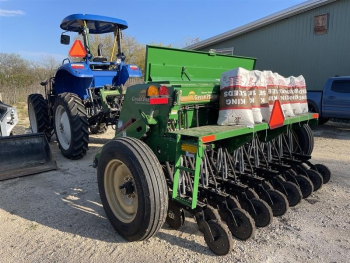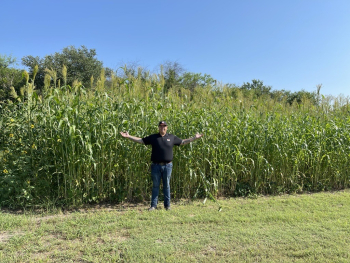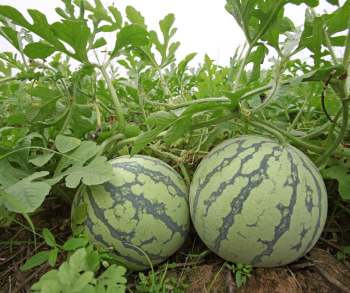Read Part 1 of Darron’s watermelon-growing journey. [1]
By Darron Gaus [2], NCAT Agriculture Specialist
The Sweetest Story Ever Told
I’ve grown watermelons in all kinds of ways: direct-seeded and transplanted, on bare ground and with plastic mulch, with furrow irrigation, drip tape, and sometimes just the stubborn hope of a well-timed thunderstorm. These experiences have taught me to watch closely, to observe how vines respond to the soil, to heat, to insect pressure, and most of all, to water. Because in every method, every season, water is the common thread. And as the years go by, it has become clear that the real story I’ve been a part of isn’t just about melons—it’s the slow reckoning of how we treat the land that sustains us.
One of the most interesting ways I grew watermelons happened from an accidental trial. The farm I managed was connected to a food bank which allowed me close connections with what seemed like the entire city of San Antonio. I had free mulch delivered regularly to maintain the farm roads. I had personal relationships with code enforcers. It seemed like every city employee had my cell phone number.
One day, I got a call that I could hardly believe. The city had tried a composting program, but it wasn’t going well, so they were going to sell their operation. First, though, they needed to get rid of all the inventory sitting in their yard. They called me and said they could deliver as many truckloads of compost as I wanted. I was ecstatic, but I had to figure out how to store it all.
A few years before, when the food bank’s new parking lot was poured, a city code mandated that there had to be a certain amount of storm water drainage for every square foot of concrete. That water retention area ended up on part of the farm and became a four-acre patch of grass that I had to maintain. So I had the truckloads of compost spread across the retention area—problem solved! Or so I thought. The truckloads of sweet-smelling, farmer’s black gold sat in the retention area for only a few days before I got a call saying if I didn’t move all that compost out of the area within 48 hours, the food bank would receive a citation.
Like most farmers, I had to think quickly about a solution. Three quarters of the farm was in cover crops, and the other quarter was halfway through the season. I used my connections to ask the construction crew next door to use their earth mover and motor grader, the piece of equipment used to level ground with an adjustable blade under the center of it, to move the piles of compost onto a corner of land that was never easy to farm. The crew moved it and flattened it all out in less than four hours. The threat of getting fined was gone, but I was left with a two-acre corner of 12-inch-thick compost. Organic matter in that corner went from 4% to 100% before lunch.

No-till drill used to seed cover crops. Photo: Darron Gaus
On top of that, heavy rain was in the forecast. I gathered every bag of leftover cover crop seed and even emptied thousands of expired vegetable seed packets into five-gallon buckets. I poured the vegetable seeds into the no-till drill hopper first and then piled on about six different species of cover crop seed. There was no way I was going to calibrate this mix with any accuracy, so I set it to wide open and made myself dizzy driving in circles. I planted a 42-species cover crop mix in 12 inches of organic matter. Three days later, we got seven inches of rain over a three-day time period—I couldn’t have timed it better if I tried. The cover crop came up and flourished for months with no other precipitation or irrigation. I would notice purple mustards and melon vines creeping from the edges every time I passed by. One day while mowing the retention area, I decided to drive the mower straight through that cover crop triangle just to see what it looked like in the middle.
About six feet into the five-foot-tall herbaceous forest lay a line of melons—both musk and watermelon. Surprisingly hefty, I picked up the biggest watermelon of the bunch. I cut it open, eager even without my shaker of salt. This watermelon did not need salt. That dark green, shaded melon seemed to be laced with honey. The tender, deep red morsels melted into my memory before I could swallow. To this day, that dryland watermelon that grew with no care, no weeding, and no irrigation was the sweetest thing I have ever tasted. A little luck and a lot of organic matter was a recipe for success.
Our Best Business Partner: Water

Darron stands in front of a 10-foot-tall cover crop of broom corn.
Growing food means living in close relationship with water, or more often, the absence of it. Rainfall is inconsistent, winds unforgiving. Even in a so-called “good year,” the margin between enough and not enough can be a matter of a few weeks without rain, or a few days of extreme heat that pushes young plants past their breaking point. You come to respect water in a new way, not just as a tool or input, but as something closer to a covenant. It’s a gift that demands care. When I first started farming, I assumed more water meant better crops. Now I understand that it’s less about quantity and more about timing, soil structure, and the subtle dance between roots and rainfall. I’ve also seen how quickly that dance can fall out of rhythm.
Those creeping changes are what pushed me to adapt. Over time, I started shifting the way I approached not just watermelon but farming as a whole. I started thinking more about infiltration and retention than just irrigation. I learned to mulch, to protect the soil from baking in the sun and losing what little water it had. I planted cover crops to build organic matter, which in turn helped the soil hold water deeper and for longer. I reduced tillage, not because I read about it in a white paper, but because I saw the soil respond when I stopped disturbing it so often. Fewer weeds, fewer soil crusts, better water uptake. My methods changed not out of ideology, but out of lived necessity. Over time, those changes bore fruit.
The bigger shift wasn’t just technical; it was personal. Water became something I stopped assuming I’d always have. I started seeing it as a shared resource, something I owed not only to my current crop, but to my neighbors, my peers, and even to the land itself. I can’t see a drop of water fall without thinking about what it means to hold onto it. Not just for yield, but for legacy. That’s the real weight of conservation—it’s not just an economic decision. It’s a moral one. We’ve been given land that can feed people and water that can make it grow. To squander that through overuse or shortsightedness feels, to me, like a kind of betrayal. And when we do it right, it shows up not just in bigger yields but in better soil, stronger roots, and water that stays a little longer every year.
Melon, Water
 The beauty of watermelon is that it demands just the right amount of water—not too much, not too little. Overwater, and the vines will rot. Underwater, and the fruit will never fill. There’s a lesson in that balance, one that stretches beyond farming. It’s about living within limits. It’s about recognizing when enough really is enough, and how chasing excess too often leads to collapse.
The beauty of watermelon is that it demands just the right amount of water—not too much, not too little. Overwater, and the vines will rot. Underwater, and the fruit will never fill. There’s a lesson in that balance, one that stretches beyond farming. It’s about living within limits. It’s about recognizing when enough really is enough, and how chasing excess too often leads to collapse.
Conservation isn’t flashy, and it’s not always rewarded in the short term. But it matters. It matters when the rain doesn’t come. It matters when a well starts to sputter. It matters when a new farmer starts asking questions about how to keep things going. And it especially matters when a child bites into a slice of watermelon in July and tastes something more than sweetness—when they taste the care, the restraint, the thought that went into growing it. So yes, I still get excited about fruit set. I still thump melons to see if they’re ready, but I’m listening for more than ripeness. I’m listening to what the land is telling me about how much longer we can do this. And my job, as I see it, is to make sure the answer is: as long as we’re willing to change.
For more about Darron’s watermelon-growing journey, check out Part one of this two-part series [1].
 Click
here to print
Click
here to print